 W
WThe 10 cm Kanone 04 was a field gun used by Germany in World War I. It was the second heavy gun with modern recoil system accepted by the German Army. It was produced as a replacement for the 10 cm K 99 and the lange 15 cm Kanone 92. Although the standard version lacked a gunshield, some models, such as the 10 cm K 04/12, were fitted with a special gunshield and some other minor modifications. There was only 32 in service at the outbreak of the war.
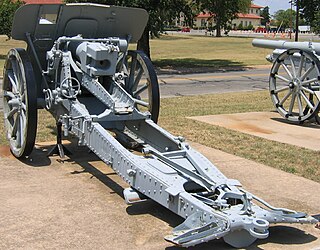 W
WThe 10 cm Kanone 14 was a field gun used by Germany and Bulgaria in World War I.
 W
WThe 10 cm schwere Kanone 18 was a field gun used by Germany in World War II. The German army wanted a new 10.5 cm gun as well as 15 cm howitzer which were to share the same carriage. Guns are heavier than howitzers due to the longer barrel. This also led to the 15 cm sFH 18. As such both weapons had a similar weight and could be carried by a similar carriage. By 1926 Krupp and Rheinmetall had specimen designs, and prototypes were ready by 1930, but was not fielded until 1933–34. Both Krupp and Rheinmetall competed for the development contract, but the Wehrmacht compromised and selected Krupp's carriage to be mated with Rheinmetall's gun.
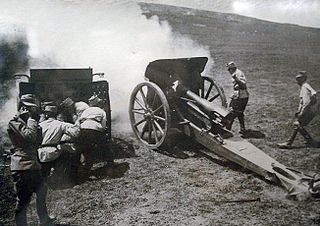 W
WThe Obuzierul Krupp, caliber 105 mm, model 1912 was a Romanian upgrade of the German 10.5 cm Feldhaubitze 98/09 howitzer used extensively during World War I. After two years of planning and experimentation by Romanian officers, the final design was approved and the required modifications were performed at Arsenalul Armatei in Bucharest. The German aiming system was replaced with an improved Romanian system and the maximum range was increased to 6,500 meters, being superior to the 6,300 meters maximum range of its German counterpart. Maximum elevation was also increased from 40° to 60°. Thirty batteries were converted by Arsenalul Armatei before and during World War I. They appear to have lingered in Romanian service into World War II. Guns captured by the Bulgarians appear to have been placed into service, although they seem to have been out of service by the outbreak of World War II.
 W
WThe 10.5 cm FlaK 38 was a German anti-aircraft gun used during World War II by the Luftwaffe. An improved version was introduced as the 10.5 cm FlaK 39.
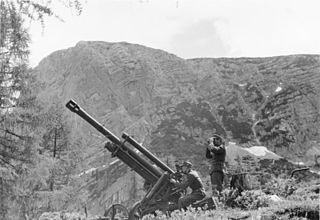 W
WThe 10.5 cm Gebirgshaubitze 40 was a 10.5 cm (4.1 in) German mountain howitzer used during World War II. A total of 420 were built during World War II. It saw action with German mountain divisions in Finland, Italy, France, on the Eastern Front and in the Balkans from 1942. It served with a number of European countries into the 1960s.
 W
WThe 10.5 cm howitzer Model 1924 was a howitzer used by the Netherlands during World War II. Fourteen were bought by the Royal Dutch East Indies Army, where they equipped the 1st Howitzer Artillery Battalion from 1924 to 1945. It is unknown if the Japanese used them after conquering the Dutch East Indies in 1942.
 W
WThe 10.5 cm hrubý kanón vz. 35 was a Czech field gun used in the Second World War. Those weapons captured after the German occupation of Czechoslovakia in March 1939 were taken into Wehrmacht service as the 10.5 cm K 35(t). Former Yugoslav guns were designated as the 10.5 cm Kanone 339(j). It was used by a variety of German units during World War II, especially on coastal defense duties. 36 were in service with the Slovak Army.
 W
WThe 10.5 cm K gepanzerte Selbstfahrlafette was a prototype self-propelled gun used by Nazi Germany during World War II. Although it was originally designed as a Schartenbrecher for use against the French Maginot Line defences, following the defeat of France it was evaluated for use as a tank destroyer on the Eastern Front.
 W
WThe 10.5 cm leichte Feldhaubitze 16 was a field howitzer used by Germany in World War I and World War II.
 W
WThe 10.5 cm leFH 16 Geschützwagen Mk VI 736 (e) was a German self-propelled artillery piece. It was created by mounting the German 10.5 cm leFH 16 field gun onto the chassis of the British Vickers Mk VI light tank. The vehicle was created by engineer Alfred Becker, who was battery chief of the 12th Battery in the 15th Artillery Regiment, 227th Infantry Division. Becker found abandoned vehicles while his unit was performing coastal protection duties in France. He made use of his artillery crews to build this vehicle and a number of others to motorize his battery. Becker's unit was the first self-propelled artillery battery of the war.
 W
WThe 10.5 cm leFH 18 is a German light howitzer used in World War II and the standard artillery piece of the Wehrmacht, adopted for service in 1935 and used by all divisions and artillery battalions. At least 22,133 examples were produced.
 W
WThe 10.5 cm leFH 18M was a German light howitzer used in the Second World War. The gun, less the carriage and shield, was also used as the armament of the Sd.Kfz. 124 Wespe self-propelled artillery vehicle. It was an improved version of the 10.5cm leFH 18 howitzer that offered superior range.
 W
WThe 10.5 cm Leichtgeschütz 40, also called the LG 40, was a German recoilless gun used during World War II. It was manufactured by Krupp.
 W
WThe 10.5 cm Leichtgeschütz 42, commonly the LG 42, was a German recoilless gun manufactured by Rheinmetall and used during World War II.
 W
WThe 10.5 cm Luftminenwerfer M 15 was a medium mortar used by Austria-Hungary in World War I. It was developed by the German firm of Ehrhardt & Sehmer. It was a rigid-recoil, muzzle-loading mortar on a fixed base that used compressed air to propel the mortar bomb to the target. Each cylinder of compressed air lasted for fifteen shots. A notable advantage was that the mortar had no firing signature, unlike conventional mortars with smoke and muzzle flash.
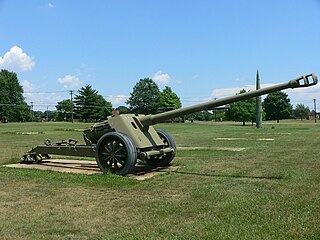 W
W105mm gun T8 was an anti-tank gun developed in the United States in mid-1940s. This gun's design was influenced by German 88 mm Pak 43/41 anti-tank guns captured by the U.S. Army in France. The development started in October 1944; the gun reached trials in February 1946. Soon afterwards the project was cancelled.
 W
WThe 105 mm Indian Field Gun was designed by the Armament Research and Development Establishment, or ARDE, in 1972. It is a towed variant of the British L13 105mm howitzer as mounted on the FV433 Abbot.
 W
WThe 105 mm Modèle F1 is a French 105 mm tank gun used with the AMX-30. A shorter version of this gun called the CN-105-57, was also used in the Israeli Super Sherman.
 W
WThe Canon Court de 105 M(montagne) modèle 1909 Schneider was a French mountain gun, manufactured by Schneider et Cie. According to Kennblätter fremden Geräts, Germany used the former French gun as the 10.5 cm GebH 343(f). The gun could be towed by a horse or mule.
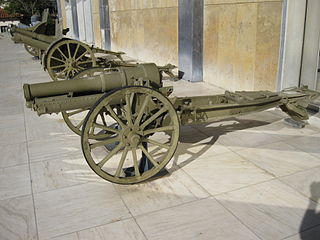 W
WThe Canon Court de 105 M(montagne) modèle 1919 Schneider was a French mountain gun produced by Schneider and intended to be used in conjunction with the 75 mm mle.19 that was used by a number of countries during World War II.
 W
WThe Canon de 105 court modèle 1935 B was a French howitzer used in World War II. It was designed by the State Arsenal at Bourges to replace the Canon de 105 court mle 1934 Schneider. Some 610 were originally ordered, although production was terminated in 1939 in favor of anti-tank guns. Only some 232 were in service when the German attacked in May 1940. Captured weapons were used by the German Heer as the 10.5 cm leFH 325(f) and assigned to training and second-line occupation units. During Italy's occupation of southern France, 127 pieces were captured by the Royal Italian Army, which used it under the name Obice da 105/153.
 W
WThe Canon de 105 L modèle 1936 Schneider was a field gun used by France in World War II.
 W
WThe Canon de 105 mle 1913 Schneider was a French artillery piece used in World War I and World War II by many European countries.
 W
WThe Canon de 105 modèle 1930 Schneider was a field gun used by the armies of Greece, Denmark, and Poland during World War II. It used the same sprung single-axle split-trail carriage as the Schneider 149 mm Modele 1929 howitzer. The gun had steel wheels with solid rubber tires and could be towed by either a horse-team or artillery tractor. It used the cumbersome Schneider-trademark spade plates that had to be hammered into the ground to anchor the gun in place.
 W
WThe CN-105-57, also known as the D1504, is a French 105 mm tank gun of 44 calibre length.
 W
WFV433, 105mm, Field Artillery, Self-Propelled "Abbot" is the self-propelled artillery, or more specifically self-propelled gun (SPG), variant of the British Army FV430 series of armoured fighting vehicles (AFVs), using much of the chassis of the FV430 but with a fully rotating turret at the rear housing the 105 mm gun and given the vehicle designation of FV433.
 W
WThe G7 is a South African 105 mm howitzer, produced by Denel Land Systems (DLS). With a maximum range of 32 km (20 mi) it outranges all existing 105 mm howitzers, as well as most current 155 mm howitzers. During development, it was known as the Light Experimental Ordnance (LEO), with the G7 label being chosen later to fit in with Denel's two existing howitzer products, the G5 towed 155 mm howitzer and the G6 self-propelled 155 mm howitzer.
 W
WThe Heuschrecke 10 was a German prototype self-propelled gun and Waffenträger developed by Krupp-Gruson between 1943 and 1944. The official designation of the vehicle was 105 mm leichte Feldhaubitze 18/1 L/28 auf Waffenträger Geschützwagen IVb and was to be built in Magdeburg, Germany. The Heuschrecke featured a removable turret which could be deployed as a pillbox or towed behind the vehicle as an artillery piece.
 W
WThe L118 Light Gun is a 105 mm towed howitzer. It was originally produced for the British Army in the 1970s and has been widely exported since, including to the United States, where a modified version is known as the "M119 howitzer".
 W
WThe LG1 is a modern 105 mm towed howitzer designed and produced by GIAT Industries of France.
 W
WThe M-56 Howitzer is a 105mm artillery gun from Serbia. Early towed version is comparable to the German 10.5 cm leFH 18 and the American M101 howitzer while newer M-56A1 and self propelled M-09 Soko has more improvements and greater range.
 W
WThe 105 mm Howitzer M3 was a U.S. light howitzer designed for use by airborne troops. The gun utilized the barrel of the 105 mm Howitzer M2, shortened and fitted to a slightly modified split trail carriage of the 75 mm pack howitzer.
 W
WThe 105 mm Howitzer Motor Carriage M7 was an American self-propelled artillery vehicle produced during World War II. It was given the official service name 105 mm Self Propelled Gun, Priest by the British Army, due to the pulpit-like machine gun ring, and following on from the Bishop and the contemporary Deacon self-propelled guns.
 W
WThe 105 mm M101A1 howitzer is an artillery piece developed and used by the United States. It was the standard U.S. light field howitzer in World War II and saw action in both the European and Pacific theaters. Entering production in 1941, it quickly gained a reputation for accuracy and a powerful punch. The M101A1 fires 105 mm high explosive (HE) semi-fixed ammunition and has a range of 12,330 yards (11,270 m), making it suitable for supporting infantry.
 W
WThe M102 is a light, towable 105 mm howitzer used by the United States Army in the Vietnam War, the First Gulf War, and the Iraq War.
 W
WThe M108 Howitzer is an American self-propelled 105 mm howitzer, first introduced in the early 1960s as a replacement for the M52 self-propelled howitzer.
 W
WThe M119 howitzer is the US designation for the L118 light gun, a lightweight British 105 mm howitzer also used by the United States Army. It can be easily airlifted by helicopter, or dropped by parachute. It does not need a recoil pit.
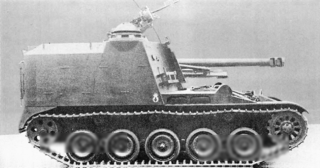 W
WThe Mk 61 105 mm Self-Propelled Howitzer was a French self-propelled artillery piece designed and built during the late 1950s for the French Army.
 W
WThe Obusier de 105 modèle 1950 was a French Howitzer designed and built after World War II for the French Army.
 W
WThe OTO-Melara Mod 56 is an Italian-made 105 mm pack howitzer built and developed by OTO-Melara. It fires the standard US type M1 ammunition.
 W
WThe Royal Ordnance L7, officially designated Gun, 105 mm, Tank, L7, is the basic model of the United Kingdom's most successful tank gun. The L7 is a 105 mm L/52 rifled design by the Royal Ordnance Factories intended for use in armoured fighting vehicles, replacing the earlier 20-pounder (84 mm) tank gun mounted on the Centurion tank. The successful L7 gun has been fitted on many armored vehicles including the British Centurion, the German Leopard 1 and early variants of the US M1 Abrams.
 W
WThe Skoda 105 mm Model 1939 was a mountain gun, manufactured by Skoda Works as a companion piece for the 75 mm M.39. This was a revised version of the 100 mm M.16 and 100 mm M.16/19. Like them it was broken down into three loads, each towed by a pair of horses, for transport.
 W
WThe Type 14 10 cm cannon was the first medium caliber cannon totally of Japanese design and the first with a split trail carriage. The Type 14 designation was given to this gun as it was accepted in the 14th year of Emperor Taishō's reign (1925). It was used Imperial Japanese Army but was not considered successful and was replaced by the Type 92 10 cm cannon.
 W
WThe Type 38 10 cm cannon was a field gun used by the Imperial Japanese Army during World War I, the Second Sino-Japanese War and World War II. It was a licensed copy of a 1905 Krupp design. The Type 38 designation was given to this gun as it was accepted in the 38th year of Emperor Meiji's reign (1905). By 1941 it was thoroughly obsolete and relegated to second-line service.
 W
WThe Type 74 105 mm self-propelled howitzer is only used by Japan. It shares a number of automotive components with the Type 73 Armored Personnel Carrier which was developed during the same time. Komatsu developed the chassis, while the howitzer and turret were designed by Japan Steel Works. The first prototypes were completed in 1969–70. The howitzer was accepted for service in 1974.
 W
WThe Type 91 10 cm howitzer was a 105 mm (4.13 in) howitzer used by the Imperial Japanese Army during the Second Sino-Japanese War and World War II. The Type 91 number was designated for the year the gun was accepted, 2591 in the Japanese imperial year calendar, or 1931 in the Gregorian calendar.
 W
WThe Type 92 10 cm cannon was a field gun used by the Imperial Japanese Army during the Second Sino-Japanese War and World War II. The Type 92 number was designated for the year the gun was accepted, 2592 in the Japanese imperial year calendar, or 1932 in the Gregorian calendar. The Type 92 cannon was intended to supersede the Type 14 10cm cannon in front-line combat service.
 W
WThe Sd.Kfz. 124 Wespe, also known as Leichte Feldhaubitze 18/2 auf Fahrgestell Panzerkampfwagen II (Sf.), is a German self-propelled gun developed and used during the Second World War. It was based on a modified Panzer II chassis.
 W
WThe XM104 was a U.S.-developed self-propelled amphibious/air-droppable/heliborne 105 mm howitzer. Pilot models of the howitzer were built by the U.S. Army Ordnance Tank Automotive Command's Experimental Division at the Detroit Tank Arsenal shops, Warren, Mich.